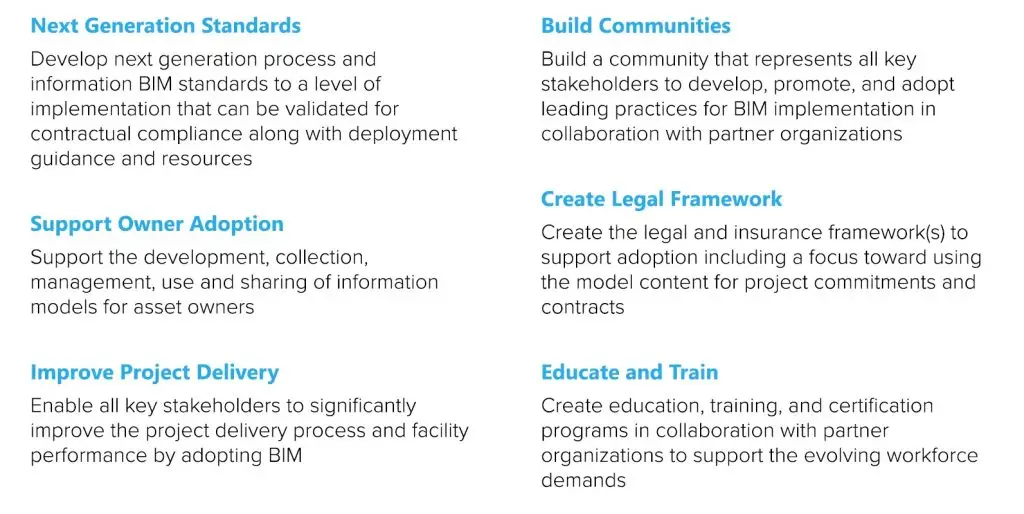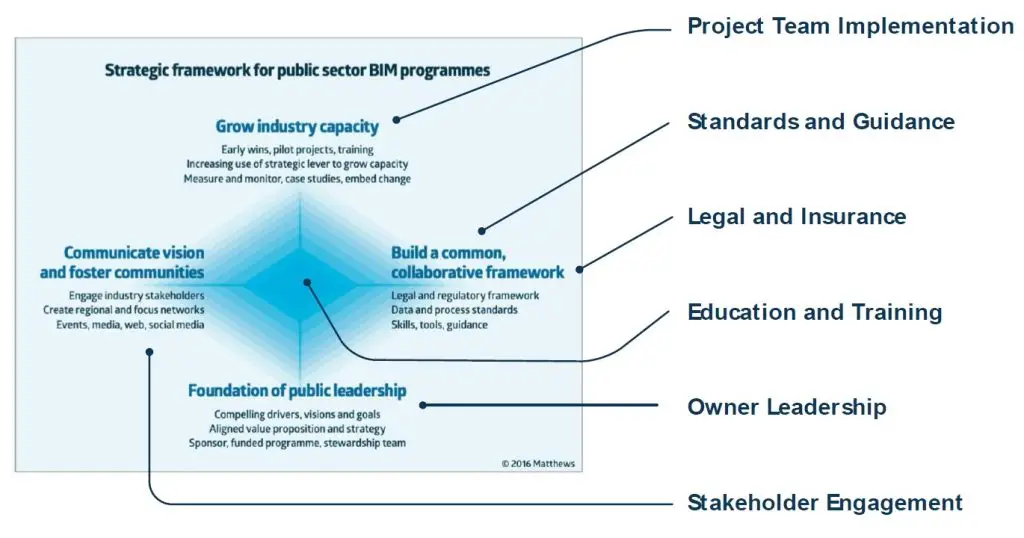The digital transformation of the AEC industry leverages digital technologies and processes, aiming to boost productivity within companies throughout all the phases of an asset life-cycle. In the U.S., the National BIM Program proposed for the next five years plans to increase the use of BIM in the later stages of a Project, the construction and operation phases. Full-scale digitalization has potential savings between 13% to 21% in the construction phases and 10% to 17% in the operations phases. (The Boston Consulting Group, 2016)
Even though major technology advances have significant potential for the industry’s digitalization and while numerous organizations have implemented BIM by standardizing workflows, adopting national and international standards such as the ISO 19650 series, developing internal definitions of roles and processes, etc., it can be noticed that barriers against digitalization are still palpable, mainly in the later phases of an asset life cycle.
With other industries being significant steps ahead on the digital transformation path, the AEC industry, even with the considerable effort being made over the last decade to foster better practices by adopting BIM and new technologies, yet due to the vast size of the sector and lack of digitalization, several stakeholders haven’t implemented those initiatives into their companies nor projects. Therefore, collaboration is one of the National BIM Program foundations, including all the relevant stakeholders, not only for the project team but also for owners and people involved in the asset’s contractual and legal processes.
The U.S. context
The construction industry employs over 7 million people to create or renovate nearly $1.4 trillion in built assets annually (National Institute of Building Sciences, 2022). Thereby, digital transformation is crucial not only for the industry to improve productivity, profits, and timing; but also, to better face increasingly complex projects.
Significant advances have taken place in the U.S. regarding BIM, mainly in adopting and creating new technologies to implement and improve the methodology worldwide. Despite this considerable effort, U.S. participation in the definition of standards is yet to be relevant.
Last year, the National Institute of Building Science (NIBS) published the National BIM Program for the U.S. to increase digitalization in the built environment. This document aimed to enable stakeholders involved in the asset life-cycle to: “efficient delivery and operate projects leveraging structured asset information.” (National Institute of Building Sciences, 2022). One of the main pillars proposed to achieve this goal is actively participating in the definition and implementation of the next-generation standards by coordinating with relevant organizations and stakeholders, both local and international, involved in developing BIM standards.
The National BIM Program has adopted a broader perspective that considers all the data management processes during a construction asset’s entire life cycle to define BIM. Therefore, the current worldwide accepted definition of BIM as Building Information Modeling is being replaced with Building Information Management, a more comprehensive concept defined as:
“… the organization and control of the business process by utilizing the information in the digital prototype to affect the sharing of information over the entire life cycle of an asset.” (National Institute of Building Sciences, 2015)
The Program
The National Institute of Building Sciences (NIBS) officially published the U.S. National BIM Program in September 2022. However, behind the document, exhaustive work had been done through collaborations with relevant organizations, communities and other stakeholders in both public and private sectors, such as building and infrastructure owners. All of them aim to improve the built environment’s digital transformation and information management practices.
Acknowledging the potential value of BIM in the operations and maintenance phases, and the challenges the U.S. faced to accomplish those benefits, is one of the main pillars of the National BIM Program. There is a need for a common framework with an industry-wide approach to produce and manage high-quality data and deliver it throughout the entire asset’s life cycle to all the stakeholders, from the designers to the owners of the projects, assuring data integrity in the whole process.
Additionally, due to the declining U.S. labor force, there is a demand for accelerating digital transformation by adopting more industrialized construction methods and digital information delivery practices to ensure the built projects’ accomplishment.
To face the multiple challenges in the U.S. digital transformation road, the National BIM Program has defined six goals whose core value relies upon collaboration among team members during the delivery but also operation and maintenance stages. Education and training of the team members will support collaboration while spreading the use of a common BIM framework.

Other countries have developed their own standards and structures within the public sector. The National BIM Program took as a reference the common Strategic Framework adopted by the U.K. and other European countries to define U.S. goals by establishing specific Workstreams that encompass the four core areas defined in the Strategic Framework (EU BIM Task group, 2018):
- Grow industry capacity
- Foundation of public leadership
- Communicate vision and foster communities
- Build a common collaborative framework.

The six workstreams
1. Owner Leadership
Supporting owners from both building and infrastructure projects seeks to increase their participation in digital transformation and successfully adopt BIM and new technologies in the maintenance and operations of an asset. The Program focuses on “setting consistent BIM requirements and obtaining quality information from project delivery to support the operations and maintenance of assets.” (National Institute of Building Sciences, 2022). Furthermore, the Owner Leadership Workstream supports research and development for innovation in project delivery.
2. Project Team Implementation
To deliver high-quality data to owners to maintain and operate their assets, identifying and addressing the Project Team’s needs will be essential during the Project lifecycle. This means making visible the potential value BIM has for the Project and how it is relevant for each team member, as defining consistent objectives with clear processes and deliverables to achieve specific BIM Uses. To support this workstream, sharing reference implementations of BIM and global best practices that highlight the value of BIM will motivate project teams and promote better practices within companies.
3. Standards and Guidance
Multiple people are involved in a built asset’s life cycle, so ensuring data integrity is a significant challenge for the industry. There is an opportunity not only to broaden and spread the adoption of national and international standards and guidance, but to increase U.S. participation in their definition, also providing a more comprehensive approach for new BIM requirements that consider project delivery, operation and maintenance phases and all the roles, and processes involved.
4. Stakeholder Engagement
There is no common framework that gathers all the industry stakeholders. Likewise, efforts do not point to the same objective, which complicates and delays the digital transformation across the built environment. These communication barriers hindered collaboration and investment in common BIM standardization and adoption. Hence, performing research about the market’s current situation in the U.S. will provide a more comprehensive perspective to a better decision-making process and help to identify stakeholders and their particular needs. Additionally, the National BIM Program will launch official communication channels to gather reliable information and promote participation in the industry.
5. Education and Training
Quality education and training are needed to spread the common language for BIM. Thus, the importance of supporting education and training development with cohesive content aligned to the National BIM Program and providing guidance around the relevance of the educational programs or certifications for the people or companies’ particular needs.
6. Legal and Insurance
Delivering model-based projects requires a legal and insurance framework to implement BIM into contracts for BIM projects and services. This will include providing guidance and legal documentation for owners and project teams and collaborating with other organizations involved in permitting, certification and other contractual procedures.
Across the upcoming five years (2023-2027), distinct initiatives and programs are set to be implemented to develop each workstream. Multiple organizations, institutions, owners, designers, builders, etc., will support the definition and implementation of those initiatives within the industry, backed by the National Institute of Building Science, a full-committed organization with the built environment evolution.
Further steps
The digital transformation aimed at the National BIM Program will only be possible due to all the stakeholders’ commitment. While organizations and institutions gather efforts and run the strategies and activities described in the plan, project teams, owners and other contributors could begin identifying needs and opportunities inside their own companies or projects and implementing BIM initiatives aligned with the U.S. goals and workstreams.
Performing a company diagnosis to collect information about its current situation, needs, and opportunities will help identify how BIM’s value could be relevant. This means highlighting processes and workflows that could be improved, necessary roles to fulfill the multiple tasks, and technological infrastructure, including the hardware and software required according to the services offered.
For this matter, research and investigation are crucial when implementing BIM. In this way, one of the solutions provided by the National Institute of Building Sciences (NIBS) is the Whole Building Design Guide – WBDG (www.wbdg.org). A web-based platform that gathers updated and relevant information for the construction industry, including codes & standards, guides, cases of study, etc. It also provides a solid continuing education program with an extensive course catalogue for various disciplines and subjects about assets’ project delivery, construction, operation and maintenance.
The complexities inherent in BIM adoption, such as data integration, software customization, and change management, may underscore the need for expert guidance. Engaging with seasoned professionals brings a wealth of experience, insights, and best practices that can support the implementation process toward success. From initial strategy development and team training to ongoing troubleshooting and optimization, professional aid helps that the transition to BIM is not just a technological change, but a holistic transformation of project delivery.
DBABIM understands that successful BIM implementation involves a strategic and transformative shift in project delivery, operation and maintenance methodologies. The company offers a comprehensive suite of services that encompass not only technical support but also strategic planning, customized training, and ongoing consultation. By collaborating closely with clients, DBABIM tailors its approach to each organization’s specific needs and goals, ensuring a holistic and sustainable integration of BIM.
Conclusion
In conclusion, the U.S. National BIM Program represents a significant leap toward the construction industry’s digital transformation. By focusing on collaboration, stakeholder engagement, and standardized practices, the plan aims to address the challenges of integrating Building Information Modeling (BIM) into all stages of an asset’s life cycle. This approach acknowledges the industry’s complexity and offers a comprehensive framework for enhancing productivity and adapting to a changing labor landscape.
The National Institute of Building Sciences (NIBS) is pivotal in guiding this transformation, facilitating collaborations, and providing resources like the Whole Building Design Guide (WBDG). The plan’s multi-faceted approach, aligned with international standards, emphasizes education, training, and the collective effort of various stakeholders.
The National BIM Program’s implementation promises a more streamlined, collaborative, and technologically advanced future as the U.S. construction sector confronts challenges and opportunities. Just as DBABIM recognizes the importance of professional support in BIM adoption, the National BIM Plan highlights the significance of industry-wide commitment to reshaping the construction landscape.
References
EU BIM Task Group. (2018). Handbook for the introduction of Building Information Modelling by the European Public Sector: Strategic action for construction sector performance: driving value, innovation, and growth. Retrieved from http://www.eubim.eu/handbook/
National Institute of Building Sciences. (2015). U.S. National BIM Standards – Version 3. Retrieved from https://www.nationalbimstandard.org
National Institute of Building Sciences. (2022). U.S. National BIM Program: The Foundation for Digital Transformation of Capital Facilities and infraestructure. Retrieved from https://www.nibs.org/usbimprogram
The Boston Consulting Group. (2016). Digital in Engineering and Construction: The Transformative Power of Building Information Modeling. Retrieved from http://futureofconstruction.org/content/uploads/2016/09/BCG Digital




